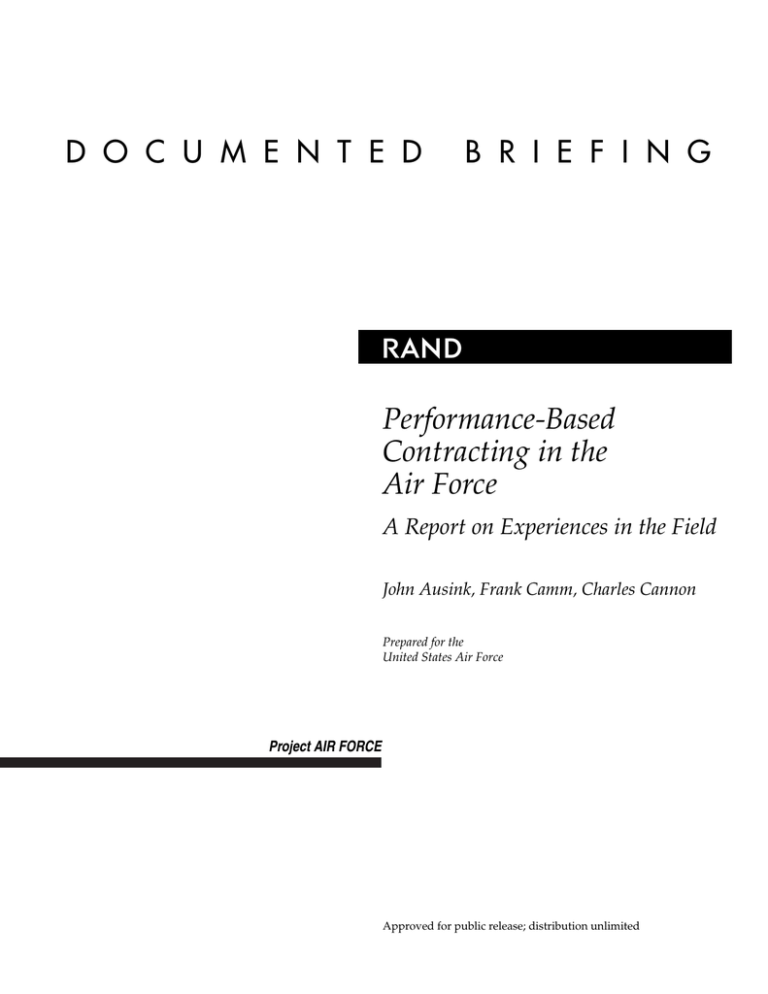
D O C U M E N T E D
B R I E F I N G
R
Performance-Based
Contracting in the
Air Force
A Report on Experiences in the Field
John Ausink, Frank Camm, Charles Cannon
Prepared for the
United States Air Force
Project AIR FORCE
Approved for public release; distribution unlimited
The research reported here was sponsored by the United States Air Force under Contract
F49642-01-C-0003. Further information may be obtained from the Strategic Planning
Division, Directorate of Plans, Hq USAF.
ISBN: 0-8330-3049-3
The RAND documented briefing series is a mechanism for timely, easy-to-read reporting of
research that has been briefed to the client and possibly to other audiences. Although
documented briefings have been formally reviewed, they are not expected to be comprehensive
or definitive. In many cases, they represent interim work.
RAND is a nonprofit institution that helps improve policy and decisionmaking through
research and analysis. RAND ® is a registered trademark. RAND’s publications do not
necessarily reflect the opinions or policies of its research sponsors.
© Copyright 2001 RAND
All rights reserved. No part of this book may be reproduced in any form by any electronic or
mechanical means (including photocopying, recording, or information storage and retrieval)
without permission in writing from RAND.
Published 2001 by RAND
1700 Main Street, P.O. Box 2138, Santa Monica, CA 90407-2138
1200 South Hayes Street, Arlington, VA 22202-5050
201 North Craig Street, Suite 102, Pittsburgh, PA 15213
RAND URL: http://www.rand.org/
To order RAND documents or to obtain additional information, contact Distribution
Services: Telephone: (310) 451-7002; Fax: (310) 451-6915; Email: order@rand.org
vii
SUMMARY
A performance-based contract tells the seller what the buyer wants done, not how to do it,
and since 1991 it has been the policy of the federal government that agencies use
performance-based contracting methods to the maximum extent practicable when
acquiring services. Department of Defense interest in performance-based contracting has
increased in recent years, and in April 2000 the Under Secretary of Defense for
Acquisition and Technology directed that 50 percent of service acquisitions be
performance based by the year 2005. A variety of Air Force instructions, publications,
and policies are in place to aggressively implement this policy.
The primary goal of this study is to use examples of successful Air Force applications of
performance-based services acquisition (PBSA) to illustrate how to pursue these practices
elsewhere. In this documented briefing, the results of interviews with personnel at Air
Force bases that have used PBSA are arranged as a “walk-through” of the process of
applying these techniques to the development of a contract. On the basis of these
interview results, we reach several conclusions about what seems to work in the field and
what needs to be improved, and we then summarize these conclusions in a list of lessons
learned from experiences in PBSA implementation.
INTERVIEW RESULTS
We conducted interviews with contracting and functional (e.g., civil engineering [CE]
and services [SV]) personnel at 15 Air Force bases representing five major commands
(MAJCOMs). In these interviews, we discussed the implementation of PBSA in 22
recent contracts—most of them for military family housing (MFH) maintenance, grounds
maintenance, custodial services, or food services. The 15 bases were “self-selected” in
that they had responded to a request for examples of “successful” implementation of
PBSA practices and had done so on the basis of their own perception of what success
means.
Motivation for Using PBSA
Most bases applied PBSA techniques because of MAJCOM direction or the introduction
of Air Force Instruction (AFI) 63-124.1 A few, however, used the approach because of
dissatisfaction with the performance of contractors selected by other methods and would
thus have used PBSA even without headquarters direction. These self-motivated
contracting offices generally expressed the most satisfaction with the outcome of the
approach.
1
AFI 63-124, Performance-Based Service Contracts (PBSC), April 1, 1999. This instruction prescribes
how the Air Force will implement performance-based services contracting and quality assurance in
accordance with Federal Acquisition Regulations.
viii
Getting Started
AFI 63-124 directs the establishment of a customer-focused, multifunctional team called
a Business Requirements Advisory Group (BRAG) to manage a service contract
throughout the life of a requirement, and a large majority of the contracts in this study
(some of them developed before the release of AFI 63-124) used formal BRAGs or
equivalent teams. There was genuine enthusiasm for the effectiveness of these teams;
they were said not only to have increased the efficiency of the process of contract
development, but also to have helped team members develop a sense of collective
“ownership” of the process.
Training
The contracts in this study were awarded from FY 1998 to FY 2000, with the most recent
having been awarded in mid-FY 2000. Everyone we interviewed said that they had
received insufficient training before being asked to implement PBSA practices. Although
many had received basic briefings on different aspects of PBSA (writing statements of
work [SOWs], for example) and some had received excellent assistance from MAJCOM
headquarters, the majority opinion was that more training was needed earlier in the
process. Most of those interviewed expressed a desire for “hands-on” training with
detailed examples and step-by-step work through the development of a PBSA contract.
SAF/AQC has begun efforts to improve training (and some new training programs were
praised by the one person we interviewed who had recently attended), but those we
interviewed also noted that basic training in the contracting career field does not yet
address PBSA practices. Several interviewees also mentioned that training should be
provided to functional representatives in addition to contracting personnel.
Market Research
Personnel we interviewed used a variety of methods in conducting market research,
ranging from combing the Yellow Pages to conducting site visits at organizations that
were using the services of interest. Although some found it difficult to find commercial
firms that operated under circumstances similar enough to those of the Air Force to
provide useful information, many were able to use their market research to aid in the
development of the SOW and to provide insight into performance factors that should be
considered in the solicitation.
Defining Requirements
In conferences and seminars, Air Force MAJCOM representatives have speculated that
implementing PBSA practices would require waivers of many AFIs and the eventual
revision of others. Because of these comments, it was surprising that, with only one
exception, no mention was made in our interviews of formal MAJCOM guidance for
PBSA implementation, and no bases revealed that they had to request waivers for any
AFIs. At some bases, frustration was expressed that they would write SOWs in
accordance with perceived MAJCOM guidance only to be directed to change what they
had done because of changes in headquarters policy that had not been announced.
Air Education and Training Command (AETC) appears to have fairly strict guidelines for
what level of service is allowable in grounds maintenance, custodial, and refuse/recycling
ix
contracts. Bases that desire higher levels of service must pay for them by diverting funds
from other sources. Although none of the AETC personnel we interviewed said this was
a problem, it is easy to imagine scenarios in which the Air Force might not get “best
value” if a base were faced with the choice of either paying out of its own pocket to get
higher performance or settling on a poorer performer that just met the AETC standard.
SOW and Quality Assurance Surveillance Plan Development
The majority of the personnel we interviewed reported substantial decreases in the
lengths of SOWs for their contracts, and review of the actual SOWs showed that many of
these decreases had resulted from language changes that focused on what was to be
accomplished rather than how to accomplish it. In only one case did it appear that the
SOW was shorter because it made references to AFIs rather than quoting from them.
All the bases in the study reported a shift to customer complaint as the primary method of
quality assurance, although some had implemented the approach more thoroughly than
others. In fact, some quality assurance evaluators who claimed to rely on customer
complaints still conducted 100 percent inspections.2 Several people noted that the
dependence on, and the level of, inspections rested on the nature of the service and
vendor expertise and would be adjusted in the future if performance so warranted.
Customer education about what constituted a valid complaint was also judged to be
important.
An important and frequent comment from the field was that the shift to a customer
complaint environment had contributed to a partnering rather than an adversarial
relationship.
Contract Structure
All but three of the contracts in this study were firm fixed price (FFP). With few
exceptions, these contracts were for terms of a basic period plus four option years.
Award fees were the exception; only six of the contracts had them. However, reasons for
not having award fees varied: Some bases did not have the money to provide them; some
felt that such fees were inappropriate (in custodial contracts, for example, how can
performance merit a fee by being “cleaner than clean”?); and others felt that the Air
Force’s use of past-performance information was sufficient motivation for a contractor to
do a good job.
Most contracting officers said that they had not considered using an award term as an
incentive in a contract, but one Air Combat Command (ACC) base was experimenting
with the approach in an MFH maintenance contract.
Source Selection
The most popular forms of source selection were “best value” (9 of the 22 contracts) and
the performance-price tradeoff (PPT) method (10 of the 22). A best value approach
allows for the consideration of factors other than price in awarding a contract (e.g., past
performance of the vendor and technical expertise) so that the contract may not
necessarily be awarded to the lowest bidder. The PPT method is a simplified best value
2
That is, performance is inspected or evaluated each time a task is accomplished.
x
approach that limits the evaluation factors to price and past performance. Air Mobility
Command (AMC) appears to be encouraging the PPT approach more actively than the
other commands.
Past Performance
All the personnel we interviewed were enthusiastic about the use of past-performance
information in the source selection process. Some used “standard” questionnaires to
gather the information but noted that in the future they would work to customize pastperformance questionnaires to their specific needs. Most used follow-up telephone calls
to clarify questions about past performance as well as informal Air Force contacts to
gather more candid information. Several commented that it might be useful to develop a
central database of past-performance information on contractors that have worked with
the Air Force.
RESULTS OF PBSA IMPLEMENTATION
Effects on Performance
Those we interviewed were very happy with the performance of the vendors they had
obtained using PBSA practices. However, not enough time has elapsed to allow for an
objective evaluation of changes in performance because most of the contracts we
discussed were relatively young—i.e., in force for approximately six months.
Significantly, we saw no indication that base officials were formally comparing the
performance of the current contractor with that of the previous contractor. For example,
some officials told us that complaints were down under the new contractor, but they had
not performed any analysis of the record of complaints for the previous contractor. Other
bases required that the contractor keep metrics that could be reviewed by the base and
thus relied on the contractor to track trends. Although this is an effective approach
toward managing the current contract, it still does not help the Air Force measure
improvement over previous contracts.
Surprisingly, at only two bases did personnel attribute their success in obtaining better
contractor performance to the use of new acquisition practices and to the care they might
have taken in reviewing past performance. Most commented that they were “lucky” to
have found a good contractor.
Effects on Costs
Changes in costs resulting from PBSA practices were also difficult to determine because
of the youth of the contracts, but three other factors made the determination even more
complex. First, many of the new contracts are hard to compare to old contracts because
the scope of work has changed. Second, it is difficult to determine the accuracy of
government cost estimates that are a standard part of an acquisition. Third, it is difficult
to measure changes in “internal” costs—i.e., those incurred in the preparation of a
contract using new methods and those incurred in the management of a contract once it is
complete. For example, there were obvious costs related to increased time spent on
market research and learning how to write a performance-based SOW. Yet while many
xi
of those interviewed alluded to these costs, their sense of them was highly
impressionistic.
With respect to Air Force performance management costs, we expected that the new
focus on customer complaints would lead to a reduction in quality assurance evaluator
(QAE) manpower or workload and hence to a significant reduction in costs. But the
comments from our interviews are ambiguous. Some bases found QAE workload to be
increasing because of the expertise required to write new contracts using PBSA practices;
others reported that they still have the same number of QAEs because they continue to do
100 percent inspections as they adjust to the use of customer complaints. Those who
expected to transition from inspections to customer complaints as vendor performance
warranted were unsure of the effect this would have on future demand for QAEs.
Attitudes Toward PBSA Practices
Customers, contracting officers, and vendors were generally satisfied with PBSA
approaches to contracting. Those we interviewed said that customer complaints were
down; contracting officers felt that the process was working as it should; and vendors
appreciated being treated as part of a team. The attitudes of functionals, however, were
mixed. Some favored the team environment encouraged by the cross-functional approach
prescribed in AFI 63-124, but others were skeptical about performance-based SOWs that
they felt gave them less control over the vendor.
Reactions to AFI 63-124 were also mixed. Some felt that the flexibility of this document
gave them an opportunity to improve contracts; others felt that its ambiguity forced them
to rely too much on other documents for guidance.
CONCLUSIONS
Practices That Seem to Work
Teamwork, market research, and the use of past-performance information are three
practices that appear to be working well in the field. Teamwork helps encourage “buyin” of PBSA practices by educating all participants about them and keeping everyone
informed during the process of contract development. In the process of developing the
SOW, teaming also helps the contracting office understand the real needs of the
functional customer while helping the functional customer understand how the
contracting office needs to structure the contract to make it performance based. Those
who believed that working together helped meet the needs of the functional customer and
give the Air Force better value were most pleased with the PBSA approach.
Market research is regarded positively by those we talked to in the field, and they seem
pleased with the way it helped them apply commercial standards to their SOWs.
Everyone was pleased with the use of past-performance information in evaluating
offerors despite the added workload it required. They asserted that the Air Force gets
better value, and the knowledge that past-performance information is used provides
incentive for vendors to perform well now in order to get new business in the future.
xii
What Needs to Be Improved?
The first thing that needs to be improved is Air Force training in PBSA practices. Our
interviews indicated that what is desired is training that provides
• A better understanding of how commercial firms do things.
• A hands-on explanation of how PBSA works in the Air Force setting, preferably
illustrated with suitable case studies. The closer the case studies are to the services a
base is about to buy, the better.
• A better understanding of where to turn to get the best and most up-to-date
information on PBSA in the Air Force.
A second need in the field is better and more consistent guidance on the application of
PBSA in the Air Force and better examples in AFIs that discuss the approach.
Finally, more attention needs to be paid to the collection of data on how PBSA is
changing performance and costs associated with purchased services. The adoption of
performance-based contracting methods is ultimately a way to help the Air Force
accomplish its mission more efficiently and to obtain the best value for the American
taxpayer, and the support of leadership at the base level is critical to the successful
adoption of PBSA methods. Without data to show that PBSA is helping them do their
job better, however, these leaders will be hard to win over. With good data, the Air Force
will be able to continually improve the application of PBSA as it learns from
accumulating experience.
LESSONS LEARNED
Appendix A, a key part of this document, synthesizes varied comments from our
interviews into a set of lessons learned. We hope these lessons will be useful to those in
the field who have not yet had the opportunity to apply PBSA practices.








